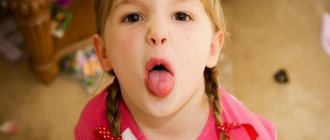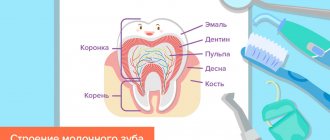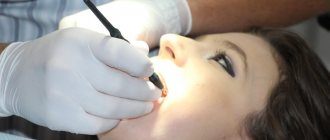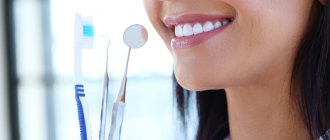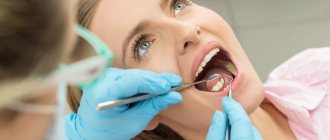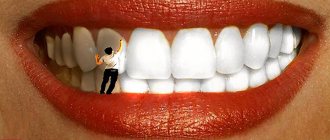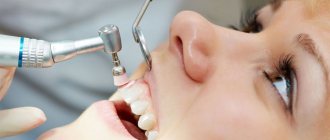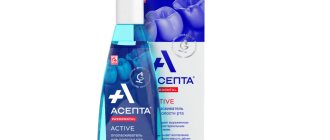In the first years of life, a child’s milk teeth erupt, he gradually begins to eat food familiar to adults, and a chewing reflex is formed. During this period, it is important to choose the right hygiene products so that the child has healthy and strong teeth in the future.
Today we will tell you how to choose your first brush and paste, prevent the development of caries in the early stages without going to the dentist, and also get through the eruption of baby teeth.
- Where do babies get caries?
- Hygiene products for the first 6 months
- What should the first brush be?
- What kind of pasta should a child under 3 years have?
- How to cure tooth decay without a dentist
- When to wean off a pacifier to avoid problems with bite
- Rules for oral care up to 3 years
- Tips from a pediatric dentist: video
Where do babies get caries?
Local immunity in the child’s oral cavity develops gradually; the first bacteria are transmitted from the mother at birth and during feeding. Initially, the oral cavity is sterile, and the microflora is formed when contacts with the outside world occur: parents lick a pacifier or bottle, try complementary feeding with a baby spoon, kiss the child.
During these contacts, bacteria are transmitted to which the immune system adapts, but it can fail due to sudden changes or illness. Transmission of harmful bacteria most often occurs at an early age through the so-called “window of infection,” but it is also possible at earlier or later periods.
The child’s microflora is not yet ready and cannot cope with many infections: thrush or stomatitis fungus, streptococci and staphylococci (provoke the development of sore throat), as well as E. coli and the herpes virus.
One of the latest studies states that the most commonly transmitted infection is Streptococcus mutans. It is this that provokes the development of caries. Moreover, it is transmitted even if the parent does not have carious teeth, since the adult’s body is more prepared to cope with viruses and infections - cariogenic bacteria do not have time to form caries in the enamel. But the baby’s body is just learning, and the baby’s risk of developing caries is higher because of this. Therefore, dentists recommend limiting contact: various licks and kisses.
The main sources of transmission of cariogenic bacteria in a child under 3 years of age: tasting food during complementary feeding, licking pacifiers, bottles and toys, kissing
Hygiene products for the first 6 months
It usually takes 6–10 months before the first teeth appear. Oral hygiene at this time is just as important as after teething, since it affects the formation of strong local immunity and the bite of teeth in the future. Note that during this period, parents should pay attention to three things in their baby’s oral care arsenal: the right pacifiers, cleaning wipes with xylitol, and a gel to facilitate teething.
Orthodontic nipples
If you use pacifiers, firstly, they must be orthodontic, and secondly, do so before 6 months, when the first teeth begin to cut. After 6 months, the pacifier may affect future bite formation.
Removal of pacifiers until 8-9 months of age forms the correct bite and helps the development of the jaw. According to studies of dental anomalies, more than half of the complaints about malocclusion are received during the period of early mixed dentition (6–9 years), but the formation of the position of the teeth begins in infancy. Parents of children participating in the study indicated that the upper incisors were tilted due to the bad habit of sucking pacifiers and fingers.
In addition, it is at this age that the sucking reflex is replaced by a chewing one, so it will be psychologically easier for the child to wean himself off the pacifier.
Philips AVENT Ultra Air pacifier 0-6 months with a pattern (2 pcs) SCF345/20
AVENT Ultra Air night pacifier 0-6 months (2 pcs) SCF376/12
Philips AVENT Ultra Air pacifier 0-6 months (2 pcs) SCF244/20
Wipes with xylitol
Until the child has his first teeth, it is recommended to use sanitary napkins with xylitol. They help maintain normal pH levels and reduce acidity levels in the mouth. Due to the increased level of acidity in the mouth, a favorable environment is created for the proliferation of many bacteria: for example, cariogenic and thrush bacteria.
To use, wrap a napkin around your finger and clean the surface of the oral cavity: gums, tongue, teeth.
Teething gels
When teething, the child may develop a fever and begin coughing from the constant flow of saliva. To avoid mistaking these symptoms for ARVI or another disease, pay attention to the following signs.
- The gums turn red and become white in places where they erupt.
- Saliva flows profusely.
- The baby puts his hands and toys into his mouth to relieve the itching.
- The baby may throw food, does not eat enough, overeats, which can cause an upset stomach.
To make teething easier, try massaging the gums with a silicone fingertip or give your child a special teether. And if local massage does not help, try special gels. They work well with teethers and finger guards and also relieve inflammation. These gels contain only harmless components of plant origin.
Jack N Jill Silicone Finger Brush (6-12 months)
Teether brush miradent INFANT-O-BRUSH yellow
Oral gel Pierre Fabre Pansoral First teeth
Teething gel BabyDerm Teething gel, 30 ml
Newborn nose care
The nasal passages are easily clogged with hairs from clothes and blankets, dust, and irritated by smoke from cigarettes, paints, aerosols, etc. Your task is to monitor the cleanliness of the air in the room and remove possible sources of pollution. If possible, install an air purifier and/or humidifier; consultants in the specialized salons of the Medtechnika Trading House will help you choose the device that suits your family. If necessary, the nasal passages are cleaned with cotton wool; they can be moistened with a solution for caring for the nasal cavity based on physiological salt solution, including sea salt (Aquamaris, Marimer, Aqualor, etc.).
If your miracle has fallen ill, then treatment of a runny nose should begin with frequent “relief” of the nose - cleaning the nasal passages with cotton wool, blowing your nose and forced aspiration of mucus, instilling drops prescribed by the doctor, etc. When using an aspirator (there are automatic B-Well and simple ones from different companies), do not insert the nozzle more than 0.5 cm. When sleeping, place the child on his stomach and turn his head to the side, this will make it easier for him to sleep.
What should the first brush be?
Dentists recommend switching to brushing with a toothbrush when baby teeth are at least halfway through. Your first toothbrush should have a compact head and synthetic bristles. In addition to the usual toothbrush, you can use a silicone finger brush: it massages the gums and relieves itching.
4 principles for choosing your first toothbrush:
- The head of the brush should be small and cover two teeth, no more. It will be very difficult to thoroughly remove plaque with a brush with a large head due to its clumsiness.
- The brush head should have silicone pads to make cleaning safe. For babies under one year old, a protective silicone ring (limiter) will not be superfluous.
- The bristles should be soft, thick and short.
- The handle of the brush should be comfortable for both the child and the parents.
From the age of 1 year, it is important to motivate children and fuel their interest in the cleaning process. Research has shown that using electric toothbrushes can be a way to build motivation. In addition, switching to an electric device improves oral hygiene compared to a manual brush: the amount of cariogenic microflora in saliva is reduced, and the risk of developing caries is reduced.
An electric toothbrush at an early age will allow the child to get used to the vibrations in the mouth, and it will be more convenient for parents to reach the distant teeth.
3 principles for choosing your first electric toothbrush:
- For children under 5 years old, it is recommended to choose models with extra soft or soft bristles.
- If the first electric brush has a bright design depicting fairy tale or cartoon characters, the child will form a pleasant association with brushing his teeth.
- The size of the brush head should not exceed 2 cm, and the handle should be rubberized. This way, the child will gradually begin to pick up the brush on his own, and the small head will allow him to brush his teeth more thoroughly.
CURAPROX Curakid Baby (0 to 4 years)
CS Medica CS-561 Kids (from 1 to 5 years) Yellow
Mega Ten Kids Sonic Kitten
Hapica Baby DBB-1Y (from 1 to 6 years)
What kind of pasta should a child under 3 years old have?
If we look at clinical studies that were conducted on the principles of evidence-based medicine, the main component in children's toothpastes is fluoride. Only they confirm their effectiveness in preventing caries.
However, it is widely believed that children under 3 years old should not brush their teeth with fluoride toothpaste. This position is due to the risk of developing fluorosis due to an excess of fluoride in the body - destruction and darkening of the enamel. But an excess of this substance is possible only in areas with a high fluoride content in water, and is also due to genetics.
The fluorine content in water can be checked on the Russian water map. And the genetic predisposition can be determined by the attending physician after passing tests. If the quality of drinking water is normal and tests are normal, dentists usually recommend using a toothpaste with a low concentration of fluoride (up to 500 ppm) at an early age.
In addition to fluorides, it is recommended to look at the abrasiveness of the paste (up to 50 RDA), as well as the presence of therapeutic and preventive additives in the composition: enzymes, xylitol, herbal extracts.
What to look for in the composition when choosing a paste:
- Abrasives - An alternative, non-traumatic but effective abrasive is silica. It is worth giving preference to toothpastes containing this substance.
- Fluorides - Organic fluorine contains compounds such as amino fluoride (olaflur).
- Dairy enzymes - lactoferrin, glucose oxide, lysozyme, lactoperoxidase. All of them stimulate the development of beneficial microflora, strengthen local immunity and restore the acid-base balance of the oral cavity.
- Xylitol is a natural sugar substitute with properties beneficial for teeth and gums. It prevents the growth of bacteria and reduces the risk of caries.
Biorepair Kids toothpaste with strawberry flavor (from 0 to 6 years)
Apadent Kids toothpaste with strawberry and grape flavor (from 0 years old)
Toothpaste Brush-Baby Apple-mint (from 0 to 3 years)
Toothpaste Mamiae Strawberry up to 6 years
Oral hygiene in children
Every parent wishes health to their baby. From birth, mothers and fathers take their babies for examinations by pediatricians and other doctors, and receive routine vaccinations. But visits to the dentist are often postponed until the tooth hurts. Many adults argue: why go to the dentist to treat baby teeth, they will fall out anyway?
When should you start monitoring your child’s oral cavity? From his birth!
It is important to visit the dentist when the baby does not yet have milk teeth, since during this period the process of microbial contamination occurs in the oral cavity. Almost all microflora is introduced from the outside due to the kisses of parents and relatives, due to the licking of nipples by adults, and sampling food from a spoon before feeding. It is a pity that pediatricians rarely draw the attention of parents to the fact that it is necessary to carry out hygienic measures in the oral cavity from the birth of a child, but his health depends on this.
The oral cavity is the most densely populated area of our body with microbes. Bacteria live on teeth, the back of the tongue, tonsils, and in the folds of mucous membranes. Caries develops when cariogenic bacteria are present in the oral cavity. Infection with them occurs during the eruption of baby teeth, that is, from one to four years. Sometimes you can see dark brown or black spots on baby teeth. These are real colonies of microorganisms. Their presence can lead to the appearance of thrush and carious destruction of baby teeth.
Daily hygiene measures carried out with the child should include oral care, which is as important as cleaning the ears, nose, and applying cream to the skin. With the eruption of the first teeth (temporary lower incisors appear at 5-6 months), it is necessary to accustom the baby to brushing them. First, you should use a silicone brush made of soft latex. Parents place the brush on their index finger, gently massage the gums and brush the child’s teeth in a circular motion from the gum to the cutting edge of the teeth.
It is advisable to carry out hygiene procedures before going to bed in the evening. At 8-10 months, be sure to brush your teeth twice a day - morning and evening; it is better not to use toothpaste, because this can cause a gag reflex.
From the age of 2, children should brush their teeth twice a day after meals. You can use children's toothpaste in small quantities, just smearing the bristles of the brush.
The key to the health of future permanent teeth depends on caring for all 20 baby teeth, which will fully erupt by age 3. Until the age of 6 years, a child must learn how to perform oral hygiene on his own without the help of adults.
Until approximately 8 years of age, parents should supervise their child while brushing their teeth. Further, control is carried out only periodically (for example, in the absence of motivation for this process, when brushing turns into scratching your teeth).
At the age of 6, permanent teeth begin to appear. Behind the milk molars, the first chewing teeth (molars) erupt, which play a major role in the formation of a mixed bite. It is at this time that you should visit the dentist for an examination.
Each age group has its own oral hygiene products. They should differ not only in size, composition, but also in design. When parents are thinking about buying a toothbrush for their child, it is advisable to do this together with him. Provide a choice of two or three toothbrushes, the handles of which will feature his favorite cartoon character. Let the child make his choice. Communication as equals and joint discussion of a purchase improves mutual understanding between parents and children.
What should a children's toothbrush be like?
Until the child is 2 years old and has learned to brush his teeth on his own, his toothbrush should have a small atraumatic rubberized head to prevent injury. You should choose a brush with an even brush field and very soft bristles, the tips of which are rounded and polished.
For children 2–6 years old, the brush should have soft bristles with rounded and polished tips, an atraumatic head no more than 20 mm and a large handle, preferably rubberized. The elongated bristles at the end of the brush field (the so-called power protrusion) effectively clean hard-to-reach areas.
At what age you can use a particular toothbrush or toothpaste can be found out from the information on the packaging.
When baby teeth are replaced by permanent ones, the set of oral care products changes. A toothbrush can be of medium hardness or soft, an atraumatic head no more than 25-30 mm (depending on the size of the teeth) with a power protrusion, the bristles should be located at different levels. If your child is unable to brush his teeth with a regular brush, try buying him a children's electric brush with soft two-level bristles and a round head, with moderate vibration.
Toothpaste must also be selected according to the age of the child. It must be safe to swallow and contain the maximum permissible concentration of fluoride, with a calcium component (up to 3 years, the paste must be fluoride-free!).
Adult pastes are not suitable for children, as they may contain antiseptics and be highly abrasive. Some children's toothpastes contain mild anti-inflammatory components - chamomile, linden (if you have allergies, it is not recommended to use toothpastes with flavors).
From 6 years of age, after brushing your teeth, you can use non-alcoholic children's rinses with a fluoride component, non-alcoholic, with a neutral flavor and a measuring cap.
Starting at the age of 2 years, after evening oral care, clean the interdental spaces with floss for sensitive teeth. It is soft and will not injure the gums.
Try to change children's toothbrushes often, as the bristles quickly become deformed and lose their ability to clean. Many manufacturers supplement children's toothbrushes with protective caps in the shape of animals. After cleaning, it is not recommended to immediately close the brush - the bristles must dry.
How to motivate a child to take daily oral care?
The most important thing here is the personal example of parents that it is necessary to brush your teeth in the morning and evening after meals. If a child has learned to hold a spoon in his hands and feed himself, then he can be taught to use a children's toothbrush. Start with the simplest thing - give your child his toothbrush. At first, he can simply gnaw on it and play around with it. Be patient. You have to stand next to him and brush your teeth. Let him see how it should be done. Then help him: take another toothbrush and brush his teeth.
If the child is not in the mood to brush his teeth, do not insist. Let this be a fun but serious game for your baby, which he will play with pleasure. It's better to spend five minutes a day learning how to brush your teeth than to spend hours at the dentist later on.
For children 2-3 years old, you can come up with a fairy tale, for example: “In one house there lived a family of teeth - dad, mom, grandmother, grandfather and a bunch of brothers and sisters. And the house is our mouth. Every day, morning and evening, they washed themselves. But one little brother did not like to wash himself. His parents explained to him: if he doesn’t wash himself, he’ll get sick...”
Or write a story about germs that destroy teeth if they are not brushed. Your teeth begin to hurt and holes appear in them. And then only a doctor will help. But to prevent this from happening, you need to clean off these microbes with a brush.
You need to talk to older children like adults. You can play dentist doctor with your child (there are special children's kits for such a game on sale). First the mother or father will be the doctor, then the child. Try to speak kindly to the patient during the game, thereby making it clear that the doctor will not cause pain.
Visit the dentist for the first time with your child to talk.
Let the doctor talk to the child, ask how he brushes his teeth, what kind of brush and toothpaste he uses.
If contact is established, the doctor may also conduct an examination of the oral cavity. If the child doesn’t want to, don’t insist. Come back in a few days. It is important that the first visit to the dentist is not related to the treatment of a diseased tooth.
Periodically examine your child's oral cavity yourself. This should be done after brushing your teeth in good lighting. If you find darkening of the enamel or a hole in your tooth, make an appointment with your doctor immediately.
To form the enamel structure, it is necessary that during the period of tooth mineralization, a sufficient amount of calcium and phosphorus enters the body. It is recommended to additionally take medications containing these microelements. Most often, caries damages molars and premolars (small molars located between the canines and molars) - after tooth eruption, the enamel is not yet mature, that is, weakly mineralized.
It is very important to visit your dentist regularly for routine checkups. The dentist will determine the level of attachment of the frenulum of the upper and lower lips, carry out professional teeth cleaning, and recommend which toothbrush and toothpaste to use to prevent diseases of the teeth and gums.
The foods a child consumes affect the tissue of teeth both during their formation and after eruption. Parents should be aware that personal hygiene, measures carried out by the dentist, a decrease in carbohydrates in the diet and an increase in vegetables and fruits can change the microflora of the oral cavity. Oral bacteria feed on carbohydrates, resulting in the formation of organic acid. It is this that causes demineralization of the enamel. In simple terms, soft plaque on teeth is food for bacteria.
It is necessary to introduce into the children's diet foods that require intensive chewing (carrots, apples, etc.), which promotes the release of large amounts of saliva and cleansing of the oral cavity. In addition, when biting and chewing food, the dental system is formed and developed. After eating, encourage your child to drink clean water or rinse his mouth.
It is not always pleasant to visit a dentist when a child has a toothache. We need to prepare for this. Explain to him that there is no other way out - the tooth must be treated. It will take a little time if he doesn't interfere with the doctor. Tell your child in detail what procedure awaits him: you will enter the office together, he will sit in a special chair, and when this chair is lowered, he will be in a lying position. They will then turn on a bright light to better see each tooth.
Before the appointment, the parent must go into the office alone, explain the situation, tell which tooth is bothering the child, and warn if this is the first visit to the dentist.
Modern pediatric dental clinics offer dental treatment under light anesthesia. The choice is up to the parents. In this case, the preliminary psychological mood of the child plays a big role. Is it worth treating one tooth under anesthesia? The child must be aware that dental treatment is necessary and may be accompanied by unpleasant sensations. You should not protect him from any troubles. We adults do this often (“Don’t go there - you’ll fall, don’t touch the sand - you’ll get your hands dirty...”), and then we want our children not to be afraid of anything. Let him fall, let him get his hands dirty, let him endure a little (in the dentist's chair, fear is stronger than pain). Then the child will have an idea of what will happen and how he will feel in this situation, and next time he will calmly go to see a doctor.
During childhood infections (for example, chickenpox) or stomatitis, rashes occur on the oral mucosa. It is at this time that hygiene should be especially careful, so children should brush their teeth 2-3 times a day. If a child does not have the strength or mood to brush his teeth during illness, then children's cleansing foams will come to the rescue. They should be used after every meal. Treat single elements of rashes on the mucous membrane with a solution of miramistin (in a spray). If there are a lot of rashes, it is advisable to rinse the mouth with an antiseptic solution. After illness, be sure to change your toothbrush to a new one.
The formation of hygiene skills begins from birth. This applies not only to brushing your teeth, but also to the ability to keep your clothes clean and to be neat at the table. After all, as they say, what we teach is what we get.
How to cure tooth decay without a dentist
It is believed that it is impossible to cure a tooth affected by caries without visiting a dentist. But only if it is not caries at the chalk spot stage - this is the initial stage of caries, when calcium is washed out of the tooth enamel. At this moment, the tooth is most susceptible to attack by cariogenic bacteria. But the damage can still be stopped without visiting the dentist.
For example, using remineralizing gels. They contain all the necessary minerals that fill the washed areas: for example, in Tooth Mousse, casein performs this function. This way the tooth regains its original appearance and receives additional protection from carious formations.
Even if a child, at first glance, does not have caries, the gel can be used for prevention.
Gel for strengthening teeth ROCS (ROCS) Medical Minerals with tuber flavor…
Gel for strengthening teeth ROCS (ROCS) Medical Minerals with fruit flavor…
Tooth gel GC Tooth Mousse Strawberry
Tooth gel GC Tooth Mousse Multifruit
When to wean off a pacifier to avoid problems with bite
The habit of putting everything in the mouth can lead to poor articulation of the tongue, lips and jaw when swallowing, as well as an open bite. Studies have shown that a child can be weaned off the habit of sucking a pacifier up to three or four years of age. But since such a habit has biomechanical reasons, it can be difficult to wean a child - in this case, the help of a psychotherapist is necessary.
To avoid problems with bite, it is important to give up the pacifier in time. By 8–9 months, if complementary foods are introduced in a timely manner, the sucking reflex is gradually replaced by a chewing reflex. It is from this age that it is recommended to start giving the baby a pacifier less - it will be psychologically and physiologically easier for him to wean himself off the habit.
Putting drops into the eyes
- Before instillation, clean the eyes with a sterile cotton swab moistened with a solution of furatsilin 1:5000
- The pipette must be washed frequently and sterilized by boiling before use.
- drops must be sterile, since the introduction of non-sterile drops leads to infection of the eye
- drop temperature is room temperature;
- Do not use a pipette with a damaged tip;
- the end of the pipette should be rounded;
- Do not allow the medicinal solution drawn into the glass end of the pipette to fall into the rubber barrel of the pipette;
- When filling, the pipette should be held strictly vertically;
- drops are instilled into the child's eyes with the participation of an assistant who holds the child in a lying position, while fixing his head, arms and legs;
- the nurse holds a pipette with a medicinal solution in her right hand, and with her left hand pulls back the lower eyelid; if the child has clenched his eyelids, he pushes them apart;
- with the fingers of the right hand, presses on the rubber balloon of the pipette and injects 1-2 drops of the medicinal solution into the conjunctival sac;
- do not drip onto the pupil area.
- remove excess moisture with a sterile cotton swab
Rules for oral care up to 3 years
Only good hygiene can help avoid caries. To ensure effective brushing, follow these rules.
- You need to brush your teeth twice a day, in the morning after breakfast and in the evening before bed.
- The correct brush movements are sweeping, from the gums to the tip of the tooth.
- Don't forget about the inner surface of your teeth.
- Show your child that you enjoy brushing your teeth. Set an example for him.
Your child’s first impressions of going to the dentist depend on oral hygiene. When the rules are followed and caries does not occur, communication with the doctor is reduced to medical examinations and does not leave terrible memories for life.
In the future, the child will trust the dentist and will tolerate possible procedures more easily. This means that caries will be treated on time and will not lead to complications.
All the most necessary hygiene products for children from 0 to 3 years old are collected in our children's set No. 1. It includes:
- Splat Baby toothpaste with apple and banana or vanilla flavors with a fingertip included;
- Curaprox Curakid toothbrush;
- Gel Pansoral “First teeth”;
- Brush Baby wipes with xylitol;
- Toothbrush holder Miradent Funny Animals.
These are basic products that will help your child maintain healthy oral microflora and fight tooth decay.
Newborn skin care
For the first 10–14 days, you can treat skin folds with a tampon soaked in baby oil (their choice is huge, just pay attention to the composition - natural is better). The skin of the body can be lubricated with milk or cream; there are also lotions and sprays to moisturize the skin. Oils for moisturizing the skin are more difficult to choose: as a rule, the oil should not clog pores or leave a greasy film on the skin, it should be quickly absorbed and leave the skin soft and velvety. Oils are more expensive because they have a natural, high-quality composition. Wash the child under running water (from front to back) after each urination and defecation and/or wipe with a damp cloth.
Girls sometimes have a cheese-like lubricant between the labia majora and minora that needs to be removed. To do this, it is enough to wipe this area for several days in a row after bathing with a swab moistened with boiled warm water or oil (for example, peach oil), from front to back. Apply a thin, even layer of baby cream to the clean skin of the buttocks and groin folds. If you use disposable diapers, then use special cosmetics. And most importantly, let your skin “breathe”! From time to time, open the baby's bottom for 10-15 minutes. In warm weather, you can let your baby sleep with his bottom exposed.
